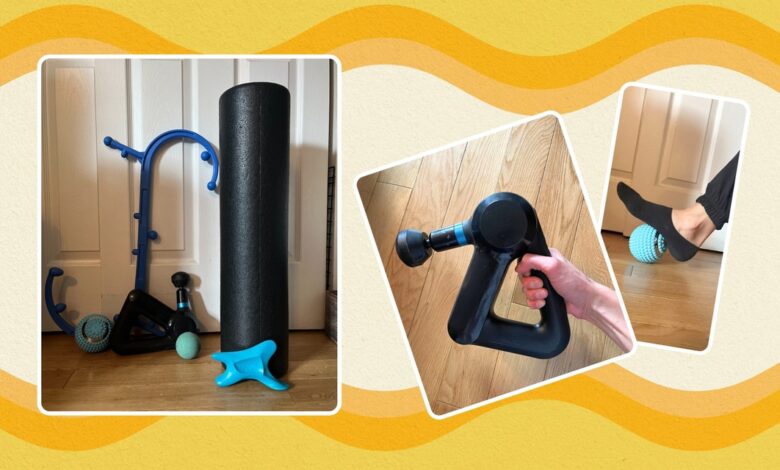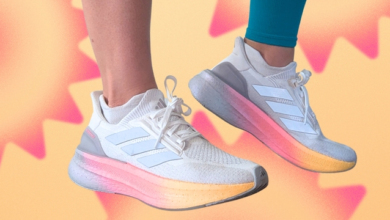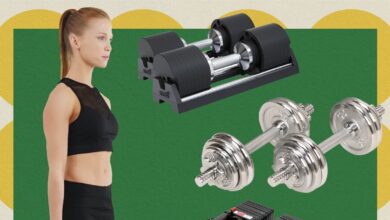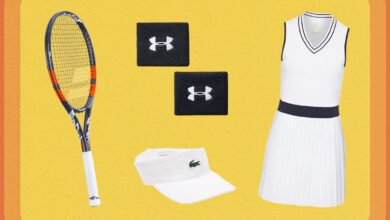My Body Is One Enormous Knot, But These Massagers Ease My Pain

Thanks to my sedentary job and body-wrecking hobbies (hi, rock climbing!), I’ve slowly assembled an arsenal of what I consider to be the best massage tools to knead my knots out at a moment’s notice—and it’s a motley bunch. I use low-tech classics, like a foam roller and a massage cane, as well as buzzy devices, like a percussive massager and a vibrating acupressure ball. I even have a handheld scraping-and-kneading tool that looks more like a paperweight than anything for muscular relief.
It’s rare that a day goes by without me (or my boyfriend, who has also contributed to this collection and deals with his own aches) reaching for one of these gadgets. Experts say that pretty much anyone can stand to benefit from self-massage tools, though the degree to which they’re effective can vary. But at least in my case, more often than not, they make a huge difference.
Our top picks
- Best Overall: Therabody TheraGun Elite
- Best Budget: Amazon Basics High Density Foam Roller
- Best for Your Arms and Hands: The Wave Tool
- Best for Your Upper Back: Body Back Buddy Classic Full Body Massage Cane
- Best for Targeted Relief: Yoga Tune Up Therapy Balls
- Best Vibrating Massager: Kanjo Vibrating Acupressure Foot Pain Relief Ball
What to know before you start using massage tools at home
Before you try a new massage tool, talk to your health care provider to make sure it’s safe for you to use one in the first place. Specifically, if you have osteoporosis, varicose veins, a blood clotting disorder, or are pregnant or recovering from surgery, you should wait to get the go-ahead from your doctor (who might tell you to avoid massage tools altogether), Andy Fata-Chan, PT, DPT, a physical therapist and fitness coach at Moment Physical Therapy & Performance in New York, tells SELF. He also notes that you shouldn’t use massagers on nerve injuries, sprains, muscle tears or strains, or acute overuse injuries (which are usually characterized by sharp pains instead of soreness).
It’s important to remember that some muscle soreness can’t be immediately fixed with self-massage, Joey Levine, CPT, CES, a personal trainer, corrective exercise specialist, and VP of fitness at Bay Club Walnut Creek in California, tells SELF. If your pain doesn’t resolve after using massage tools or gets worse, Dr. Fata-Chan recommends seeing a primary care doctor or physical therapist to get to the root of the problem.
What to look for when shopping for massage tools
There are so many different types of massagers out there—as illustrated by my own collection. That much variety can simultaneously make it easier and more overwhelming to find the right one for you. After considering your budget and space constraints (especially if you plan to keep your massager in your gym bag), the best way to narrow the field is by focusing on what you already know feels good, Dr. Fata-Chan says.
Do you mainly deal with concentrated knots? Try something that can target specific points on the body, like a therapy ball. Do you want to loosen up large muscle groups in one swift motion? Consider a high-density foam roller. If you want a more intense sensation than general pressure, opt for a tool with vibration or percussion. Whichever tool you settle on, it should be easy to use, Dr. Fata-Chan says. The more therapeutic it feels, the more relaxing benefits you’ll reap, he adds.
Here are the massage tools you knead to know about (heh). Don’t get me wrong, I go to physical therapy for more serious pains—but for sore muscles, knots, and general post-workout relief, I believe these devices are the best you can use.
Best Overall: Therabody TheraGun Elite
Pros
- Wide range of intensities
- Easy to hold and maneuver
- Comes with five attachments
- Long battery life
Cons
- Pricey
The TheraGun Elite uses percussive massage to reduce soreness all over your body. Levine says percussion therapy is key for both pre-workout warm-ups and post-workout recovery. I use mine whenever I notice a new knot, but I feel the greatest difference when I break it out after an especially tough strength training session. It comes with five interchangeable heads, many of which are designed for specific areas and uses. I prefer to use the dampener head since it’s the most versatile: I use mine on my glutes, hamstrings, quads, calves, forearms, and shoulders, and I’m always impressed by how quickly I feel relief (and, thanks to the triangular handle, I don’t tie myself into further knots to reach those areas). It definitely feels intense—I often stick to the lowest setting—so I recommend gradually increasing the massage speed.
One thing to note: You shouldn’t use a massage gun directly on your neck. As SELF has previously reported, the carotid arteries in your neck maintain blood flow from your heart to your brain. The pressure from the massager can affect (or even temporarily starve) that flow, which could cause a mini stroke or stroke-like symptoms like confusion, numbness on one side of the body, and severe headaches. The muscles in your shoulders leading up to your neck, on the other hand, are fine to hit with a little percussive massage.
Original image by senior commerce writer Sara Coughlin
Original image by senior commerce writer Sara Coughlin
Best Budget: Amazon Basics High Density Foam Roller
Amazon
Basics High Density Foam Roller
Pros
- Under $15
- Versatile
- Available in four lengths
Cons
- Awkward to store
I don’t even remember when this foam roller came into my life—it’s just always been a part of my wake-up routine. Since it doesn’t have any techy features, the intensity of the massage is totally up to me, which is nice when I’m easing into movement for the day. Rolling it under my upper back releases the tightness in my shoulder blades; using it on my legs feels invigorating and helps me get ready for a day of running around the neighborhood.
Levine says these major muscle groups are exactly where a foam roller works best. He adds that you can use it on active and rest days alike, noting that foam rolling can boost your circulation, which can help your muscles recover and feel less sore.
Original image by senior commerce writer Sara Coughlin
Original image by senior commerce writer Sara Coughlin
Best for Your Arms and Hands: The Wave Tool
Wave Tools Therapy
The Wave Tool
Pros
- Versatile and compact
- Developed for specific aches and pains
Cons
- Specialized design might not be useful for everyone
I’ve already sung the praises of the Wave Tool, but it bears repeating: If you deal with knots or soreness in your fingers, inner wrists, or forearms, you need this thing. (You can use it on your neck and legs, too, but I find it’s the most helpful as an arm and hand massager.) It has edges of various widths for scraping, a trigger-point knob for targeted relief, and a wide disc for broader kneading. Basically any end, tip, or edge of the Wave Tool is made for some kind of massage—and finding the ones that feel best is easy, since it’s so small and lightweight.
As a climber, I use it to loosen the fatigued, tight muscles in my forearms and soothe my fingers after hard sessions spent pulling on small holds. But it also helps me as a person whose hands just get tired from everyday life: Carrying bags of groceries, gripping my dog’s leash, and typing all take their unique toll. Basically, whenever I need a little pick-me-up in my hands and arms, the Wave Tool is my go-to.
Original image by senior commerce writer Sara Coughlin
Original image by senior commerce writer Sara Coughlin
Best for Your Upper Back: Body Back Buddy Classic Full Body Massage Cane
Body Back
Buddy Classic Full Body Massage Cane
Pros
- Great for hard-to-reach parts of the back
- Under $35
Cons
- Large and somewhat awkward to store
Using a massage cane is like having an extra pair of hands—suddenly, you can reach those frustratingly tight spots between and around your shoulders that often go neglected by other self-massage tools. Not only does it lengthen your reach, but it also ups the intensity with which you can massage those tricky areas, Levine says. That’s thanks to the strategically placed heads along the length of the cane. If you sit at a computer all day or spend hours craning your neck to see better at a concert, few things feel as good as working one of those knobs into your traps and under your shoulder blades.
This is another simple tool that lacks percussion or vibration, which I generally prefer when working on this part of my body. (Before I found a bed pillow that actually suits my sleep position, my massage cane was my main source of relief from the nearly constant crick in my neck.)
Original image by senior commerce writer Sara Coughlin
Original image by senior commerce writer Sara Coughlin
Best for Targeted Relief: Yoga Tune Up Therapy Balls
Yoga Tune Up
Therapy Balls
Pros
- Easy to manually increase and decrease intensity
- Under $20
Cons
- Might not feel hard enough for some people
Dr. Fata-Chan explains that if you want to target a specific area or muscle group, you’re better off using a massage ball rather than a larger tool (like a foam roller) because it can provide more pressure to a smaller spot. You can place a ball directly under the part of your body that’s bothering you, then up the intensity by leaning more of your weight into it. A good old lacrosse ball can get the job done (especially for extra stubborn knots), but sometimes it feels a little too hard. Luckily, the Yoga Tune Up Therapy Balls have a layer of rubber padding around their core, so they don’t feel as intense right off the bat. In my experience, that makes them great for tender spots and tougher areas alike.
Original image by senior commerce writer Sara Coughlin
Original image by senior commerce writer Sara Coughlin
Best Vibrating Massager: Kanjo Vibrating Acupressure Foot Pain Relief Ball
Kanjo
Vibrating Acupressure Foot Pain Relief Ball
Pros
- Nubby texture
- Long battery life
- Especially good for tense muscles
Cons
- Charging port can be tricky to find



